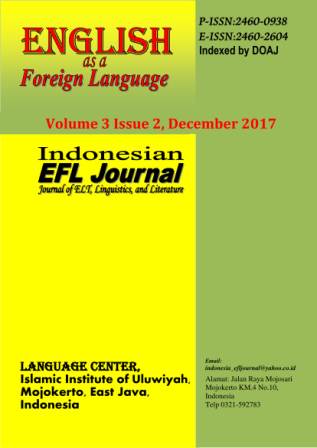Students’ Perception on the Utilization of Language Laboratory for Speaking Performances
Abstract
This article is a report of correlational research conducted to the second undergraduate English major in STKIP PGRI Banjarmasin. The objective of this research is to examine whether the students’ perception on the utilization of language laboratory in Speaking course correlate significantly with their speaking performances. The instruments used for collecting data are questionnaire and Speaking test. The result of this research shows that there is no significant correlation between them. The existence of students’ perception on the utilization of language laboratory in Speaking course does not influence and gives any valuable contribution to their speaking performances. There are extraneous and possible factors that may influence the result of this research. Finally, this research is expected to become the new perspective about language laboratory that can be utilized as interactive media or teaching aid in teaching Speaking course. Furthermore, exploring the extraneous factors that occur to students in this research is needed to be investigated widely.
References
Bush, M.D. (1997). Technology-Enhanced Language Learning. (Eds.). Michigan: National Textbook, Co.
Hasil Loka karya Silabus. (2012). Banjarmasin: STKIP PGRI Banjarmasin
Lightbown, P.M. & Spada, N. (1993). How Language are Learned. Oxford: Oxford University Press
Mintzes, J.J., & Leonard, W.H. (Eds). ( 2006). Handbook of College Science Teaching. New York: National Science Teachers Association
O’Malley, J.M. & Pierce, L.V. (1996). Authentic Assessment for English Language Learners.Practical Approaches for Teachers. Manassas: Addison-Wesley Publishing Company-Inc.
Pun, M. (2013). The Use of Multimedia Technology in English Language Teaching: A Global Perspective. Crossing the Border:International Journal of Interdisciplinary Studies, 1(1): 29-38.
Richards, J.C. &Renandya, W.A. ( 2002). Methodology in Language Teaching: An Anthology of Current Practice. Cambridge: Cambridge University Press.
Sampath, K., Pannirselvam, A., & Santhanam, S. (2001). Introduction to Educational Technology. New Delhi: Sterling Publishers Private Limited.
Satya, R.K. (2008). Modern Method of Teaching English. New Delhi: APH Publishing Corporation
Sharifian, F. (2009). English as an International Language: Perspectives and Pedagogical Issues. Bristol: Multilingual Matters.
Singh, Y.K. (2006). Fundamental of Research Methodology and Statistics. New Delhi:New Age International (P) Ltd.
Ur, P. (2012). A Course in English Language Teaching.Cambridge: Cambridge University Press
Wei, X., and Liu, Y. (Ed.). (2013). Cultivating Scheme of Students Autonomous Learning in English Listening and Speaking. Proceedings of the International Conference on Information Engineering and Applications (IFA), China.
Wilson, D.D., and Thayalan, V. (2007). The Significance of the Language Laboratory in Communication (Online). Retrieved from http://www3.telus.net/linguisticsissues / lab.
Copyright (c) 2017 Indonesian EFL Journal: Journal of ELT, Linguistics, and Literature

This work is licensed under a Creative Commons Attribution-ShareAlike 4.0 International License.
All rights reserved.
this publication may be reproduced, stored in a retrieval system, or transmitted
in any form or by any means, electronic, mechanical, photocopying, recording.




